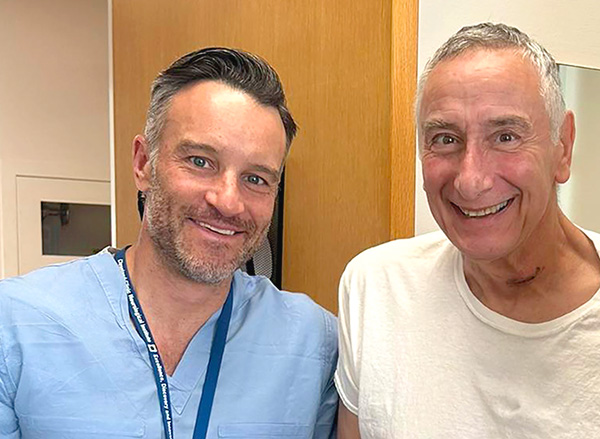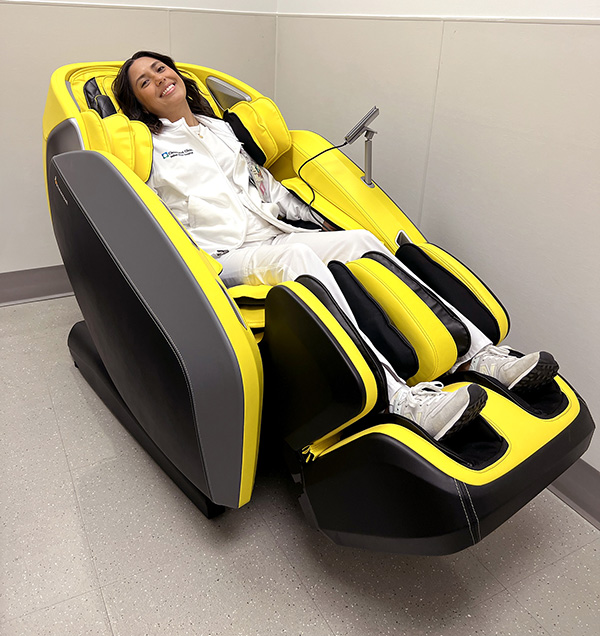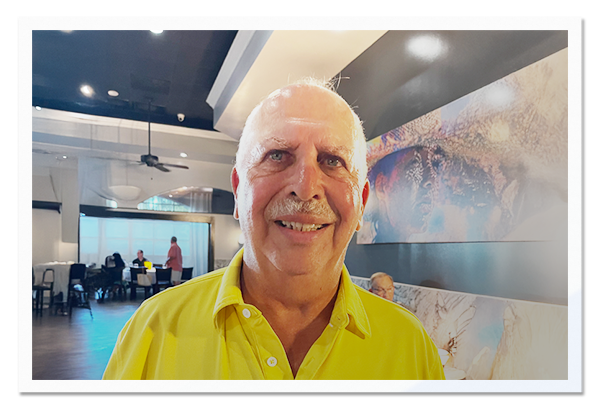New Possibilities for Stroke Treatment

After a stroke impaired his movement, Cleveland restaurateur Tommy Fello became the first person in Ohio to receive a vagus nerve stimulation device for stroke. It’s a technology that’s opening new possibilities for recovery and helping survivors regain mobility.
“At one point, I lost all motor skills on the left side of my body. My arm and leg felt like cadavers. They had no movement, nothing,” says Tommy, who had his stroke in 2023. Following treatment, he immediately went to a rehabilitation facility for three weeks. For a period, Tommy used a wheelchair but eventually regained enough strength in his leg to move more freely with a walking stick. But he was still facing challenges.
A New Way To Treat Stroke
“My arm and hand movement were way behind my leg. And since I’m a cook at the restaurant, I wanted to regain that ability and get back to work,” says Tommy.
He was intrigued when he learned about vagus nerve stimulation, which uses an implanted device to send electrical signals to the brain through a nerve in the neck called the vagus nerve. Also used to treat epilepsy and depression, this technique has been more recently approved as an add-on to rehabilitation therapy for people who have moderate to severe loss of arm and hand function from an ischemic stroke.
“We believe stimulating the vagus nerve generates some plasticity in the brain, allowing it to form new connections in areas that control motor function,” says neurosurgeon Mark Bain, MD. "When paired with stroke rehabilitation therapy, patients with this device have seen improvements in their hand and arm function."
A High-Tech Solution
Complex surgeries like the implantation of the vagus nerve stimulation device require specific needs from the operating room. Ideally, a high-tech hybrid operating room – one that incorporates both traditional surgical capabilities and interventional procedures guided by imaging (like X-rays, CT scans, or ultrasound) – would be used.
“You know, there's an operating room and there are interventional suites,” explains Dr. Bain. “What we really want to do is to optimize and improve patient outcomes by combining those two things into one room.”
Dr. Bain is excited about the possibilities of such a space for his work. “For patients, this means they would basically have combination procedures where we could do open surgical and then convert right to interventional, offering them things that really no one else in the world can offer.”
The biggest roadblock for his dream? The cost of the X-ray machine. “This is not just a normal X-ray – this is really high-powered X-ray high definition,” he says. “It’s mounted on a robot arm which moves the X-ray machine over the patient and can get good imaging and interoperative imaging. We've been to Finland, China – all over the world – looking at these rooms and only a few are being used for neurology. We're trying to build something that not many places in the entire world have to offer.”
Grateful To See Improvement
In April 2025, Dr. Bain performed the surgery to implant the vagus nerve stimulation device in Tommy’s chest. While the effectiveness of the stimulation varies from patient to patient, Tommy, now 72, is already seeing improvement in his left arm and hand function.
Cleveland Clinic is always looking for these innovative types of technologies, according to Dr. Bain. He points out that this type of procedure isn't just about surgery. “It's really an entire team that has to be assembled to first identify patients, screen them and then to do the post op, recovery and rehab. I think Cleveland Clinic is the perfect environment to do something like this because we can easily get together teams of stroke neurologists, neurosurgeons and rehab.”
Dr. Bain also notes this procedure is not an immediate, emergency procedure for treating stroke, but is the first procedure designed to help people recover later. “I think over the next 5 to 10 years the field will develop more and more of these types of post-stroke procedures to help patients.”
“The movement in my arm is getting better, and I can pick things up more easily. Some of my therapy exercises are getting easier as well,” says Tommy, who continues to push himself so that one day he can get back to work at the iconic restaurant he started in 1972, preparing dishes for the community he loves.
Make a gift here to help support innovations like the hybrid operating room in Cleveland Clinic’s new Neurological building.
A Gift of Comfort for Florida Caregivers

In 2020, during multiple hospital visits at the height of the COVID-19 pandemic, longtime Cleveland Clinic in Florida supporters Pamela and Arnie Sheiffer saw firsthand the extraordinary commitment of Cleveland Clinic caregivers. Inspired by their selflessness, the couple wanted to find a meaningful way to give back.
Pamela serves on the board of a wellness company whose primary product is massage chairs, and the Sheiffers saw an opportunity to provide comfort to those on the front lines. With the guidance of Cleveland Clinic leadership, the couple donated a massage chair to each of Cleveland Clinic’s Florida hospitals — offering caregivers a brief but meaningful moment of rest during long and challenging shifts.
Continuing Their Commitment to Caregivers
Now, with renovations underway to upgrade the caregiver lounges at Indian River Hospital, the Sheiffers have once again stepped forward to honor caregivers. After hearing that caregivers had been moving a single massage chair from floor to floor to share its benefits, they chose to donate additional chairs — ensuring every lounge has a dedicated spot for caregivers to relax and recharge.
“It is a small gift to say thank you to very special people,” says Pamela. “They deserve the very best place in which they can relax in those few moments when they are not caring for all of us.”
Thanks to the generosity of the Sheiffers, caregivers at Cleveland Clinic Indian River Hospital now have a place designed to support their well-being — allowing them to continue delivering world-class care to our community.
Grateful for Care at Martin North and Tradition Hospital

For Harold Levy, Cleveland Clinic Martin Hospital has been nothing short of life changing. His journey with the hospital began in early 2024, thanks to his dear friend, Bunny Webb, Vice Chair of the Martin Health System Board of Directors and a member of the Martin Health Foundation Advisory Board, who guided him to the care he needed.
“I was having problems with my eyes and she connected me with the proper experts who quickly treated me,” Harold recalls.
But Harold’s connection with Cleveland Clinic Martin didn’t stop there. When a long-standing health issue began to interfere with his passion for golf later in 2024, he turned to the Cleveland Clinic Tradition team for help.
“For 30 years, I had severe pain in my calves and hip. I couldn’t take it anymore—I needed back surgery,” he shared.
The experience deepened his admiration for the hospital and its staff.
“I must have been in and out at least 10-15 times for appointments, x-rays and MRIs. Everyone was so helpful and nice. Two months and two days after my surgery, I was back on the golf course,” he said.
With both health issues now behind him, Harold was inspired to give back in a meaningful way. He made a generous gift at the Cornerstone Society level to support Tradition Hospital’s capital expansion plan.
A Treasure Coast Transplant
When he’s not playing golf, Harold, 76, still works as a citrus broker – an industry he’s been a part of for 70 years. It’s a legacy that began with his father, whose entrepreneurial spirit and work ethic left a lasting impression on him.
“My father started out selling bananas to small stores in New York and New Jersey. Over time, he saved enough to buy a piece of property and build a store. Growing up, my three brothers and I all worked in the business. My mother told me, ‘The world owes you a living, but you have to work to earn it.’”
After college, Harold pursued a career in sales for various companies in the Northeast. It was through business connections that he first discovered the charm of Vero Beach and Port St. Lucie, where he was invited to play golf. He fell in love with the area and decided to purchase a home, initially splitting his time between New Jersey and Florida. Twenty-six years ago, he made the Treasure Coast his permanent home.
A Deep Sense of Gratitude
Harold believes everyone should give generously and supports a variety of causes himself. He is deeply grateful to have Cleveland Clinic so close to home. Describing himself as a grateful patient, Harold says of his gift to Tradition Hospital, "I have confidence it will be used for the greatest need."

